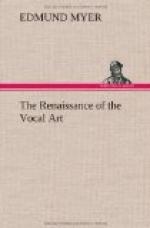The prevailing idea of placing is the thought of constantly pushing up the tone. Result, the organ of sound is pushed out of place and all true conditions disturbed. The pushed-up tone means local, muscular effort, contraction, and a hard, unmusical voice. The voice thus placed may be loud and brilliant, but never soulful or beautiful. The pushed-up tone means singing from the larynx up. It means head-resonance only; and head-resonance is but one side, and that the smallest side, of this great question.
Tone must be placed spontaneously, with reaction and reflection. This shows at once the importance of the first two great principles of voice-production,—freedom and automatic breath-control; for without these true placing is impossible. Tone placed in this way means the ring of the forward high placing and the added resonance of the inflated cavities and especially of the chest.
In singing, as we have learned, there are two forces constantly in action,—pressure and resistance, or motor power and control. These two forces must prevail, and in order to produce the voice artistically, they must be balanced. This is done, indirectly, through the movements we advocate, through the position and action of the body. The motor power lies in the diaphragm and in the abdominal and intercostal muscles. The controlling force lies in the chest, in a properly adjusted larynx and the approximated breath-bands. These two forces must be balanced during the act of singing. Most singers are much stronger in the driving or motor power than in reaction or the controlling force; and with many, the weakness in control, reaction or adjustment, is an absolute bar to success. Hence the importance of strengthening the chest, and the position of the organ of sound, through physical culture.
When these two forces, motor power and control, are not equal, the balance of force is placed upon the throat and throat muscles. This the singer can no more avoid doing than he can avoid balancing himself to keep from falling. When, in order to place, the voice is pushed up, deliberately and maliciously pushed, both forces are exerted in the same direction. They are then virtually but one force—a driving force. As there must be two forces in singing, as Nature compels this, there is nothing left for the singer to do but to use the throat and throat muscles as a controlling force. Under these conditions, as before stated, the tone may be brilliant, but it will always be unsympathetic and unmusical.
I hope no one will think for a moment, in considering the movements we advocate, that we do not believe in strength and power. We do believe in applied power, applied indirectly; not by local grip and contraction, but indirectly through vitalized energy, expansion, and flexibility, through the true position and action of the singer. There is no strength properly applied in singing except through movement; through correct movement all the forces which nature has given the singer are indirectly brought into action; in this way there is constant physical and vocal development.




